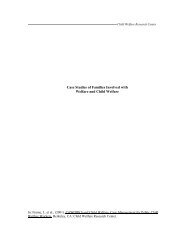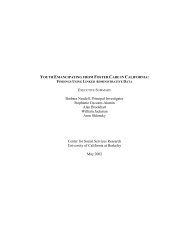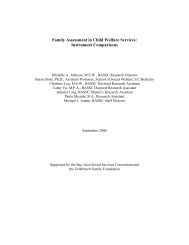Developing a Self-Assessment Toolfor Culturally - Office of Minority ...
Developing a Self-Assessment Toolfor Culturally - Office of Minority ...
Developing a Self-Assessment Toolfor Culturally - Office of Minority ...
You also want an ePaper? Increase the reach of your titles
YUMPU automatically turns print PDFs into web optimized ePapers that Google loves.
consumer focus groups, analysis <strong>of</strong> outcomes data, and chart reviews or audits (NPHHI1998).Using various methods to monitor CLAS quality is a vital step toward improvingCLAS quality (Smedley et al. 2002). Equally important, however, is how organizationsuse the data they have collected through QMI studies. As such, this domain also includesinformation on the uses <strong>of</strong> QMI data, which may include: setting priorities for healtheducation and promotion, linking patient and provider data, and setting targets or goals forservice units.Domain 5: Management Information Systems (MIS)This fifth domain—which includes assessment elements related to an organization’sdata collection efforts for its staff and clientele—is closely related to Domain 4, QualityMonitoring and Improvement. In order to effectively understand, monitor, and improvequality <strong>of</strong> health care in general, and to promote consistent and similar standards <strong>of</strong> care forall patients regardless <strong>of</strong> demographic characteristics (e.g., race, ethnicity, language,gender, age), information must be collected on the demographic characteristics <strong>of</strong> healthplan staff and the service population (Perot and Youdelman 2001; Smith 1998). Inquirieswithin this domain include whether the organization collects and records such informationfor its staff and clientele. If management information systems are in place, actual data onthe racial, ethnic, cultural, and linguistic composition <strong>of</strong> the organization’s staff andclientele would be gathered under this domain.Domain 6: Staffing PatternsThe racial, ethnic, cultural, and linguistic composition <strong>of</strong> health care staff—bothclinical and non-clinical—should reflect and represent the diversity <strong>of</strong> its servicepopulation (Kim et al. 1992). This domain covers level <strong>of</strong> staff diversity within anorganization as well as organizational efforts to recruit, retain, and promote a diverse staff.Also important in an assessment <strong>of</strong> staffing patterns are the types <strong>of</strong> organizational effortsto make information on staff diversity available to its service population (again, for MCOs,its members), such as provider directories that publish languages spoken by physicians orshow photographs <strong>of</strong> physicians and other health care staff who “look like” their members.Domain 7: Staff Training and DevelopmentOne way to improve quality <strong>of</strong> health services for culturally and linguistically diversepopulations is to hire staff who represent the cultural composition and speak the languages<strong>of</strong> the population served, discussed above in Domain 6. Another way organizations canimprove CLAS quality is to provide ongoing staff training in cultural competence or “staffdiversity training” (Cultural and Linguistic Standards Task Force 1997; NLBHW 1996).Diversity training refers to any instructional effort that addresses and promotes greaterCOSMOS Corporation, December 2003 B-3
















